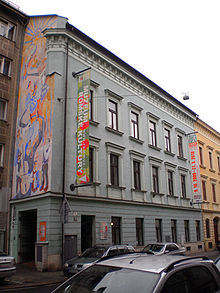- Museum of Romani Culture
-
The Museum of Romani Culture (Muzeum romské kultury in Czech) is an institution dedicated to the history and culture of the Romani people (Gypsies). It is situated in Brno, Czech Republic.
Contents
History
The Museum was founded in 1991 by members of the Czech Romani intelligentsia, led by Jana Horváthová, in the period of freedom which followed the Velvet Revolution in Czechoslovakia. During its early years, its location moved from one place to another and the institution struggled with financial problems. In December 2000, it moved to its present building on Bratislavská Street in Brno, which is the centre of the local Romani community. The museum is now financed from the state budget.
On December 1, 2005, the first permanent exhibition was opened.
Exhibitions
The permanent exhibition [1] covers 6 rooms with an area of 326 m². It is dedicated to the life, culture, and important events of the Romanis during their migration from India until the present day, with emphasis on the situation in Czech lands during the period 1945–1989.
Temporary exhibitions, mostly art and photography, are created from time to time.
In addition to the exhibitions, the museum is also a place of Romani research in Central Europe. With a public library, students and other interested people have a chance to select from more than 3,000 publications (books, magazines, CDs). The museum organizes lectures, concerts, panel debates and Romany language courses for the public and professionals. In the afternoon the club is opened for Romani children from the neighbourhood.
Library
The library sources include important research papers and prints, Romani literature, news articles in Czech and Slovakian (regarding to Roma), news articles about Roma in foreign languages, overview of legislations, printed discussions and debates.
See also
- Romani contemporary art
External links
- The Museum of Romani Culture (Czech)
Other Romani museums:
- Documentation and Cultural Centre of German Sinti and Roma in Heidelberg, Germany (German, English)
- Ethnographic Museum in Tarnów, Poland. Click menu ROMA (CYGANIE) on the left. (Polish, English, Romany)
Coordinates: 49°12′02.52″N 16°37′26.76″E / 49.2007°N 16.6241°E
Categories:- Museums established in 1991
- Romani culture
- Museums in the Czech Republic
- History museums
Wikimedia Foundation. 2010.

